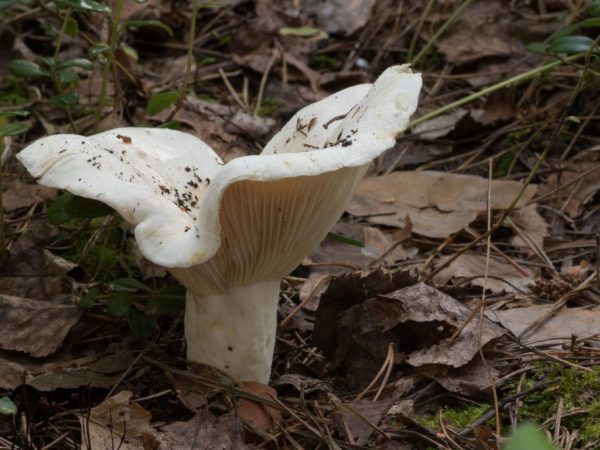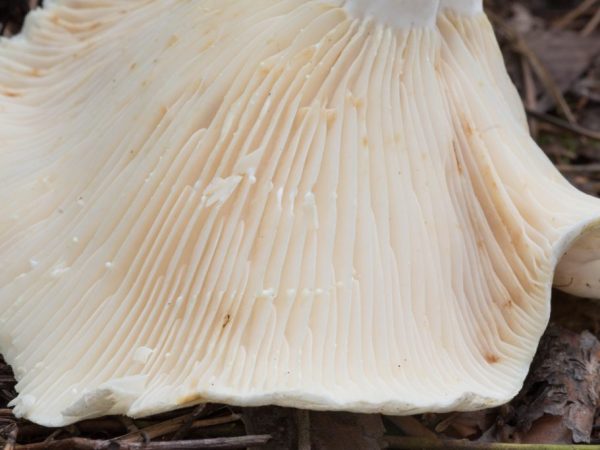Features of the violin mushroom
The violin mushroom got its name for its characteristic sound - a creak, which is heard when the fruit bodies of the mushrooms come into contact with each other.

Features of the violin mushroom
Description
Lactarius vellereus, or felted milk, squeaky, violinist, milkweed or spurge - this is also called this conditionally edible organism. White juice with a peculiar aroma stands out from its cut.
It belongs to the 4th category of edibility, to the class Agaricomycetes, the genus Mlechnik and the russula family.
Description of Lactarius vellereus:
- funnel-shaped cap;
- cracked edges;
- size - from 7 cm to 25 cm;
- color is milky white;
- the pulp is tough and fragile;
- turns yellow on the cut;
- leg up to 5 cm in height, 4-5 cm in diameter;
- the color of the leg is pure white;
- the plates are rare (the distance between them is 0.5-1 cm).
The caps of the young violin mushroom have cracked shaggy edges bent towards the stem. The name "felt" mushroom received for its inherent slight hairiness of the surface of the cap. The plates underneath are light cream, delicate and fragile.
By the way. The cap of the violin is characterized by variability: it can acquire a yellowish or reddish-brown tint with ocher spots, and the plates can be greenish or yellow and sometimes with the presence of ocher spots on the surface, like a cap.
The leg tapers towards the ground. If you cut it off, milky juice is released, which gradually dries up, does not change its color. Dry juice looks dull.
When you touch each other in a basket or when you slide your finger over the cap, a characteristic creak is heard, hence the name squeaky mushrooms.
Views
The violin is a mushroom that lives in coniferous and mixed forests. Where there is a lot of moss, old rotted leaves and enough lighting. The mushroom loves to settle at the foot of birches and aspens. It often forms mycorrhiza with birches; it is characterized by the formation of mycorrhiza with various types of coniferous and deciduous tree species. It grows with whole families in summer and autumn.
It has several similar species, so when harvesting it is important to understand their differences, although there are no poisonous ones among them.
Irina Selyutina (Biologist):
The squeaky has, if I may say so, a twin mushroom - Bertillon's milkman (Lactarius bertillonii). Outwardly, it is almost impossible to distinguish between them. The only difference is the taste of milky juice - soft and only slightly tart in the violin and very hot in the milky Bertillon. To determine the species differences, you can also take a solution of caustic potassium (KOH): when interacting with it, the milky juice of the milkman Bertillon (it is with him, this reaction is not typical for the violin) changes its color: first it turns yellow, and then orange.
The types of "podskrebysh" include:
- aspen squeak;
- real lump;
- peppercorn;
- loading.
The real breast milk differs from the squeak by the shaggy edges of the cap, the hollow stem (in old specimens) and rare plates under the cap, which are exclusively white (but in the violin they are light yellow).In addition, the milky juice of the milk jug turns yellow when it comes into contact with the air, while the squeak remains the same.
Squeaky mushrooms have a bitter milky juice. According to the description, the edges of the cap of the podgruzki are fluffy, not torn, the stem becomes hollow and brown with age. Thin plates are often located.
The surface of the cap of the peppercorn is even, without fibers and scales. The juice at the break has a green color with an olive tint and a peppery aroma. The leg is dense and solid. The plates of the pepper fungus, thin and narrow, are often located.
Beneficial features

Mushrooms lower cholesterol
Like other forest mushrooms, the felt mushroom, or the violin mushroom, has many beneficial properties that are due to its composition. It contains a lot of fiber, vitamins and minerals necessary for the human body.
One serving of properly prepared milkweed can fill the daily requirement for phosphorus, iron, sodium and potassium.
Periodic use can normalize cholesterol levels and lower blood sugar levels.
Skripun supports the general condition of the body, serves as a natural antibiotic and helps fight viral and bacterial diseases. It contributes to the overall strengthening of the immune system and restores the energy balance of a person.
For all its low calorie content (22 kcal per 100 g), the mushroom gives a quick feeling of fullness. When following a diet for weight loss, it is used as a protein substitute for meat or fish.
Harm and contraindications
In nature, mushrooms are sponges that freely absorb and accumulate harmful substances from the atmosphere, soil and groundwater. It is better not to collect them near expensive and factories, near residential areas.
Among the negative properties, the severity of digestion is distinguished, which is formed by the presence of chitin in the cell walls of the fungus. If mushrooms are improperly cooked, after eating them, heaviness, cramps and pain in the stomach appear.
In case of problems with the gastrointestinal tract, gastritis or ulcers or low acidity, it is better not to eat dishes with milkweed.
For children, such food in the diet without consulting a pediatrician is prohibited due to the severity of digestion and excess salt. It is better for women in position not to eat salted mushrooms: they retain water in the body and lead to unwanted edema.
Application
Despite belonging to the 4th flavor category, the violin is successfully used in cooking. Due to its chemical composition, it has found application in traditional medicine.
Application in traditional medicine
A tincture and extract are made from the fruiting body with the addition of alcohol. They serve as a good remedy for inflammation and for the prevention of tumors.
Chinese healers use these alcoholic tinctures in the treatment of joints, tendons of the limbs, lumbago and pelvic bones.
Cooking applications
The taste of fresh violin is bitter and pungent. It does not disappear after boiling or frying. Substances in the composition of the fungus irritate the stomach and cause a gag reflex, so the euphorbia is prepared in a special way.
This conditionally edible organism is edible only when salted. Before the process of salting, the mushrooms are thoroughly washed, sorted, cleaned of leaves and dirt. Then comes a long period of soaking (up to a week), so that the bitterness of the milky juice comes out, all toxins and harmful elements go away.
The process is accelerated with boiling water, in which the scraper is immersed. The water is changed several times a day (up to 5). This is done for 3-4 days.
In a pan prepared for salting (or a wooden or glass container), a layer of spices is laid on the bottom: bay leaf, allspice peas, if desired - currant or cherry leaves, top with caps down - scrapes. Sprinkle with ordinary rock salt. Salt is added at the rate of 50 g per 1 kg of product.
Lay everything out in layers, put a wooden circle or a ceramic plate on top in diameter and something heavy to press down on everything.
After 3-4 days, the juice will stand out, the mushrooms will decrease in size, but will not yet be ready to eat. It takes up to 14 days for full readiness. Please note! During salting, the temperature should not rise above + 10 ℃ so that your workpiece does not rot.
After that, the pickles are put in clean, sterilized jars and rolled up with lids. They are stored in a dark and cool place.
Conclusion
Unique and special violin mushrooms delight with taste. The main thing is to be able to cook them.


